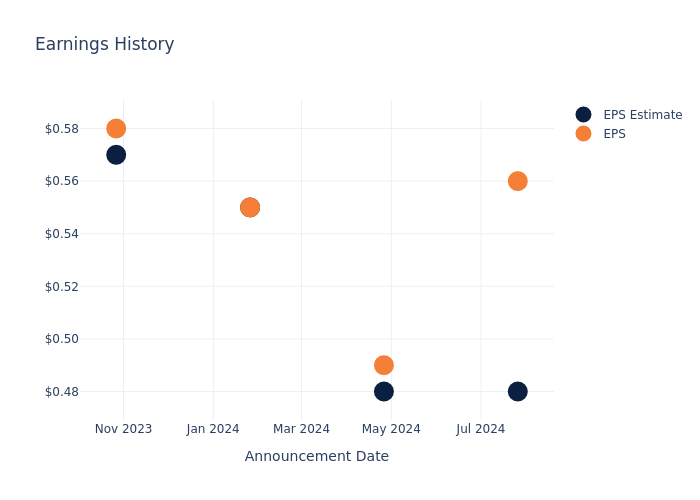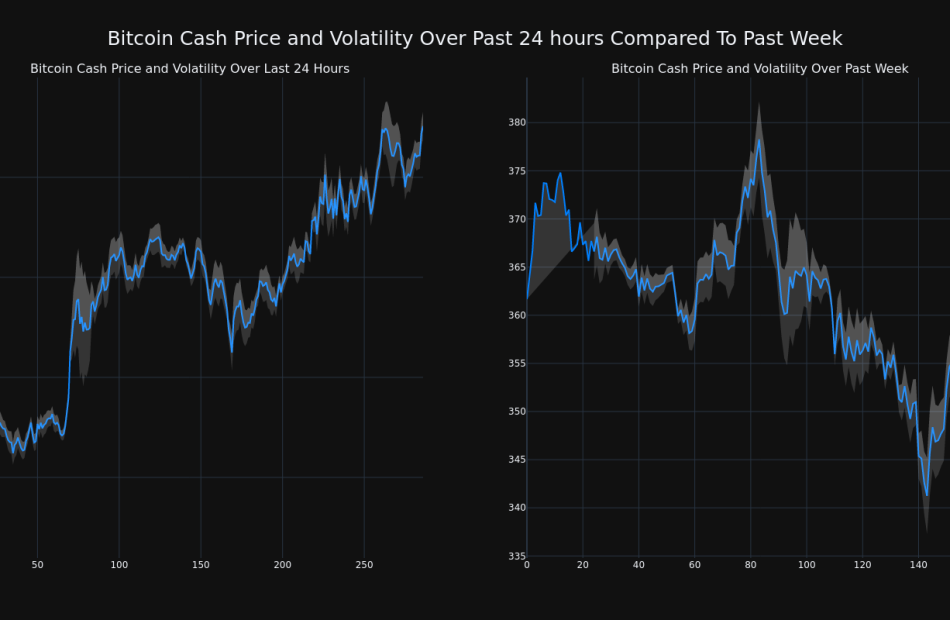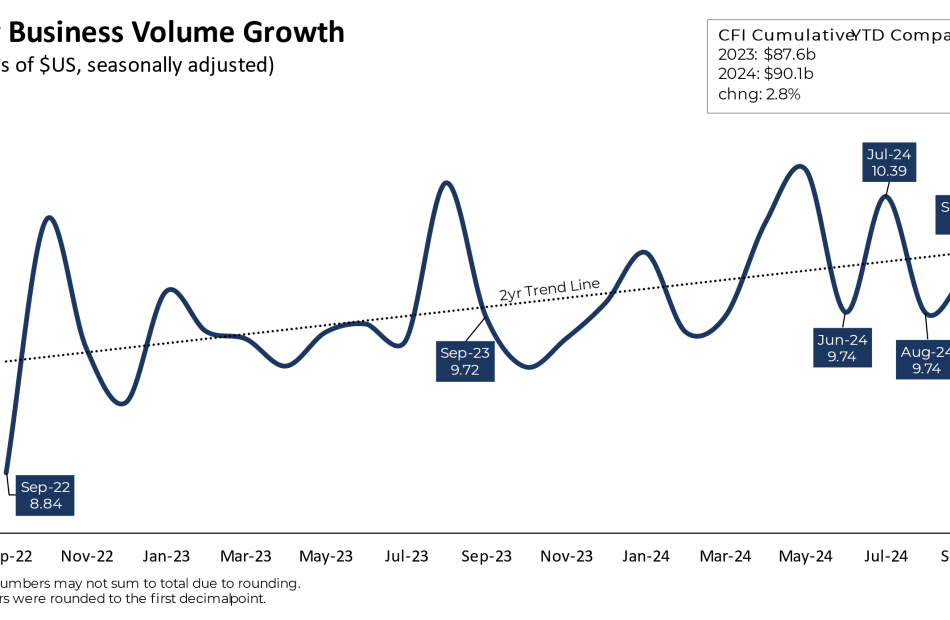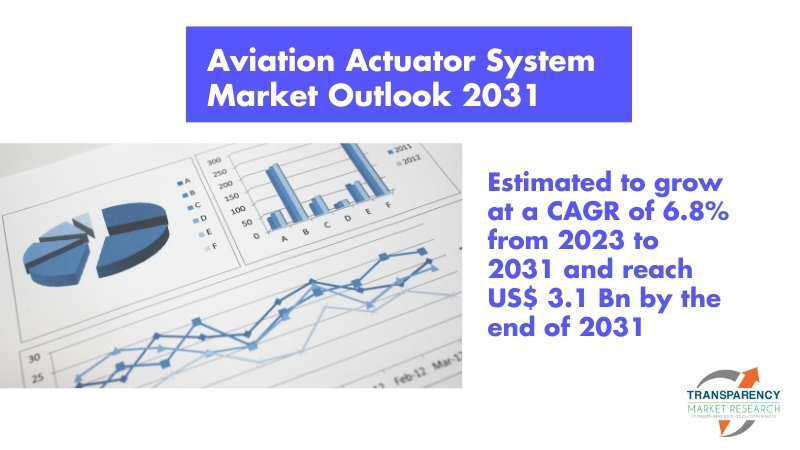What's Next: Stellar Bancorp's Earnings Preview
Stellar Bancorp STEL is set to give its latest quarterly earnings report on Friday, 2024-10-25. Here’s what investors need to know before the announcement.
Analysts estimate that Stellar Bancorp will report an earnings per share (EPS) of $0.48.
The announcement from Stellar Bancorp is eagerly anticipated, with investors seeking news of surpassing estimates and favorable guidance for the next quarter.
It’s worth noting for new investors that guidance can be a key determinant of stock price movements.
Historical Earnings Performance
The company’s EPS beat by $0.08 in the last quarter, leading to a 0.0% drop in the share price on the following day.
Here’s a look at Stellar Bancorp’s past performance and the resulting price change:
| Quarter | Q2 2024 | Q1 2024 | Q4 2023 | Q3 2023 |
|---|---|---|---|---|
| EPS Estimate | 0.48 | 0.48 | 0.55 | 0.57 |
| EPS Actual | 0.56 | 0.49 | 0.55 | 0.58 |
| Price Change % | 1.0% | -6.0% | 0.0% | -3.0% |
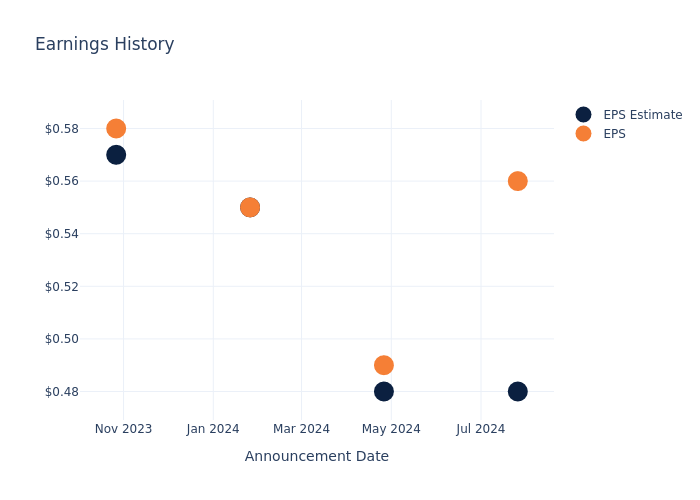
Tracking Stellar Bancorp’s Stock Performance
Shares of Stellar Bancorp were trading at $26.19 as of October 23. Over the last 52-week period, shares are up 20.93%. Given that these returns are generally positive, long-term shareholders are likely bullish going into this earnings release.
To track all earnings releases for Stellar Bancorp visit their earnings calendar on our site.
This article was generated by Benzinga’s automated content engine and reviewed by an editor.
Market News and Data brought to you by Benzinga APIs
© 2024 Benzinga.com. Benzinga does not provide investment advice. All rights reserved.
Bitcoin Cash's Price Increased More Than 5% Within 24 hours
Bitcoin Cash’s BCH/USD price has increased 5.65% over the past 24 hours to $362.7, which is in the opposite direction of its trend over the past week, where it has experienced a 0.0% loss, moving from $361.67 to its current price. As it stands right now, the coin’s all-time high is $3,785.82.
The chart below compares the price movement and volatility for Bitcoin Cash over the past 24 hours (left) to its price movement over the past week (right). The gray bands are Bollinger Bands, measuring the volatility for both the daily and weekly price movements. The wider the bands are, or the larger the gray area is at any given moment, the larger the volatility.
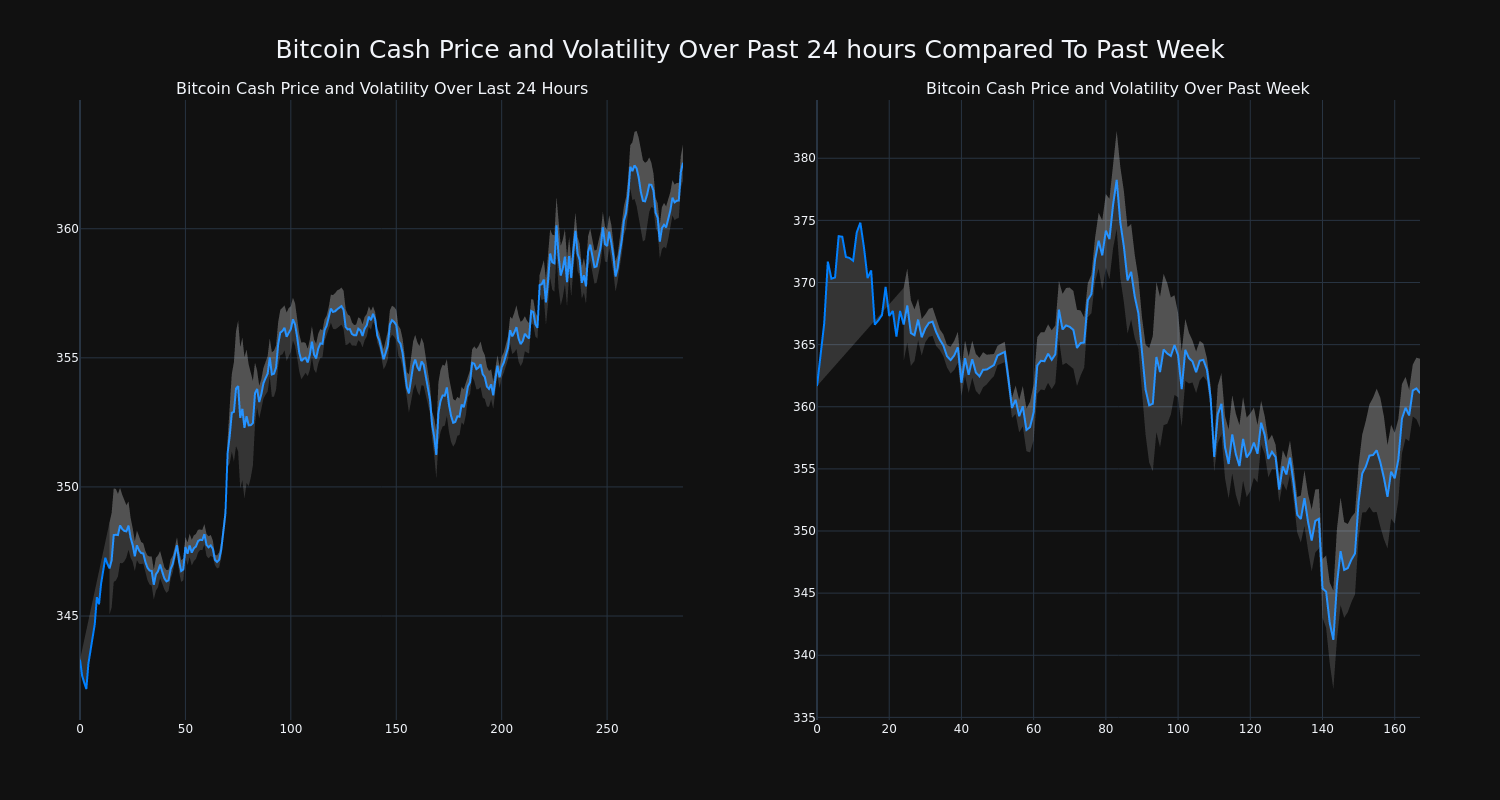
The trading volume for the coin has tumbled 20.0% over the past week while the circulating supply of the coin has risen 0.01%. This brings the circulating supply to 19.78 million, which makes up an estimated 94.18% of its max supply of 21.00 million. According to our data, the current market cap ranking for BCH is #19 at $7.18 billion.
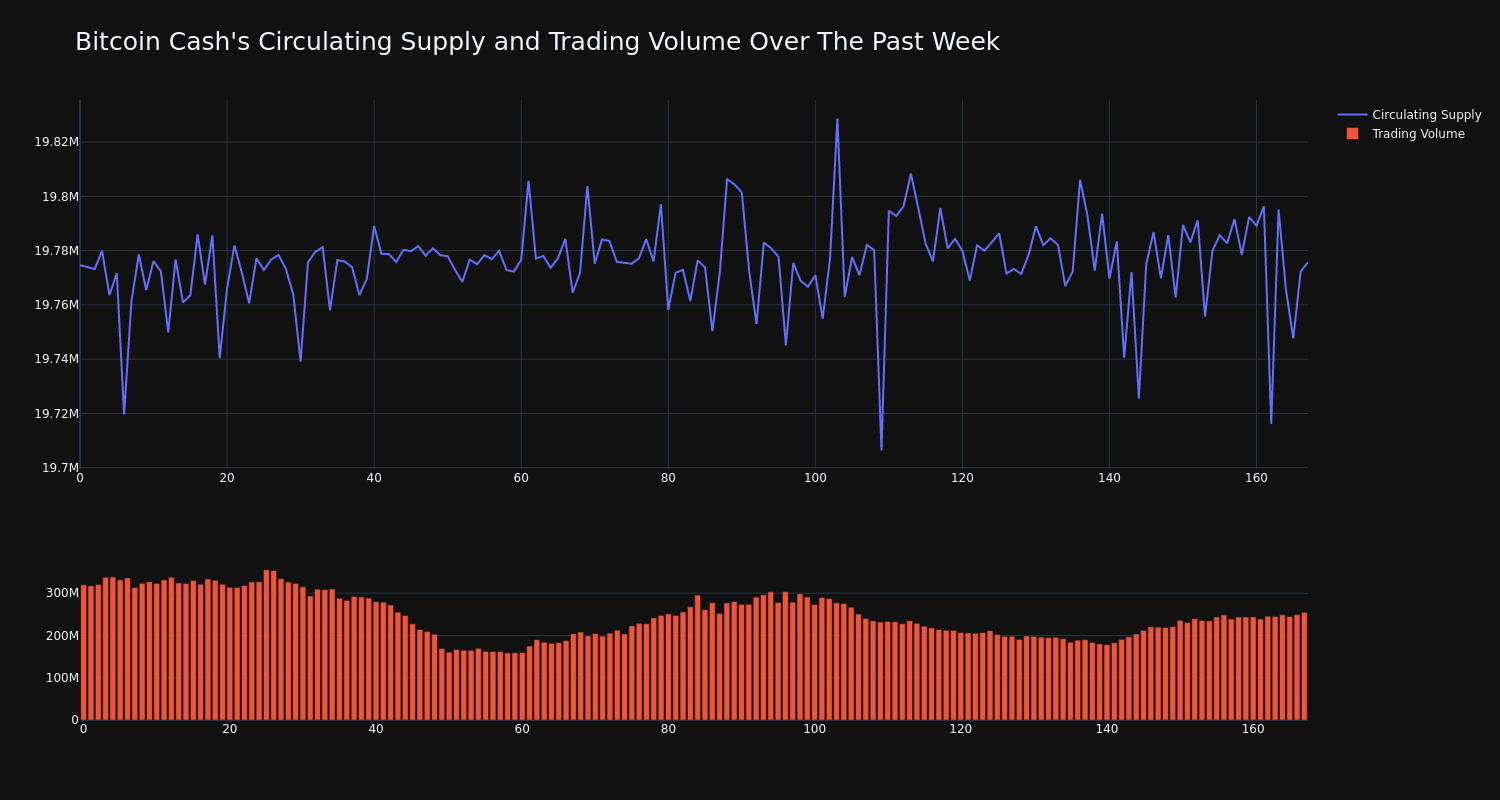
This article was generated by Benzinga’s automated content engine and reviewed by an editor.
Market News and Data brought to you by Benzinga APIs
© 2024 Benzinga.com. Benzinga does not provide investment advice. All rights reserved.
Equipment Leasing and Finance Association CapEx Finance Index: September 2024
********************************************************************************************************
Note to readers: ELFA has updated the name of the Monthly Leasing and Finance Index (MLFI-25) to the CapEx Finance Index (CFI) to better reflect what it measures and how it impacts the broader U.S. economy.
********************************************************************************************************
WASHINGTON, Oct. 24, 2024 (GLOBE NEWSWIRE) —
Demand for equipment picked up. New business volume grew by $10.0 billion from August to September, a monthly increase of 2.2% before rounding. Growth in business volume has been uneven in 2024 but continues to hover around historic highs. The September release suggests that equipment investment continued to expand at a healthy pace at the end of the third quarter.
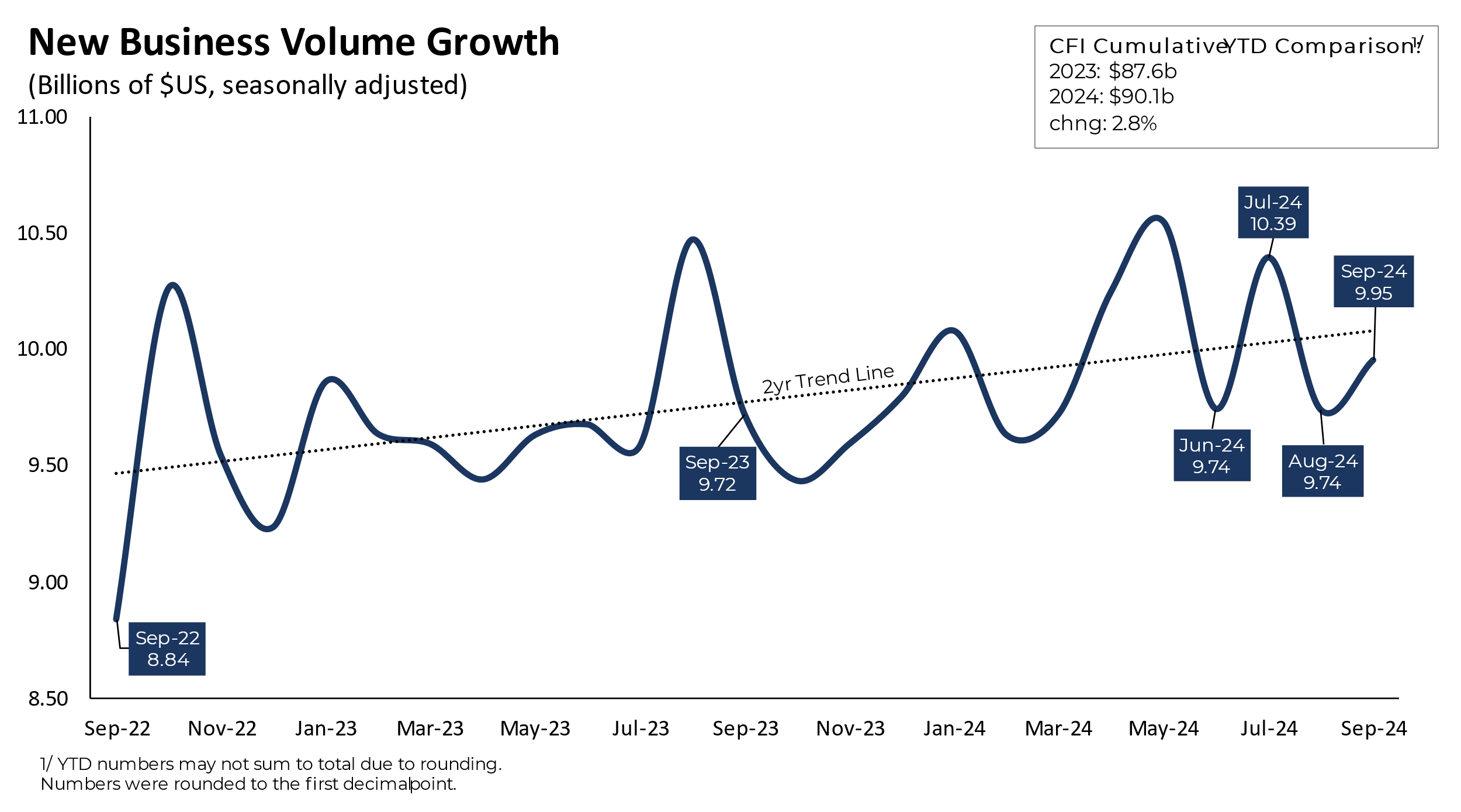
Bank lending drove new business growth. The sub-index for business volume at banks grew by 10.9% from August to September, which was more than enough to offset the contraction in activity at captives and independents, which declined by 2.3% and 9.8%, respectively. The figure below shows that bank activity has lagged other sources over the last few years, but the latest data suggests that banks may be easing back into the lending and leasing market.

Lenders continue to add headcount. The 12-month change in employment was just over 1.0%, slightly slowing from the 1.2% pace recorded in August. Employment has been a source of strength this year, following nearly five years of persistent declines in headcount.
Credit approvals remained steady. The percentage of credit applications approved ticked down 0.7 percentage points to 75.6%. The approval rate has been hovering around 75% for most of 2024.
Lender balance sheets improved for a second consecutive month. The percentage of credit lines over 30 days past due and charge-offs declined. Both have been trending up over the last two years as borrowing conditions tightened due to the rapid increase in interest rates.
Industry Confidence
The Monthly Confidence Index from ELFA’s affiliate, the Equipment Leasing & Finance Foundation, is 61.8 in October, steady with the September index of 61.9, which was the highest level since January 2022.
Industry Voices
“Our latest CapEx Finance Survey showed that equipment demand continued to defy high interest rates in September. The uptick in bank lending was particularly encouraging and is something I will be watching closely as we approach the end of the year. I wouldn’t be surprised if the next few surveys show a cooling in lending volumes as election uncertainty peaks and some businesses wait for rates to drop further. That said, balance sheets continued to improve, and the percentage of approved new credit applications remained healthy, signs that lenders and borrowers are in a great position to weather any gusts that might come along in the fourth quarter.”
ELFA President and CEO, Leigh Lytle
“A healthy increase in YOY business volume, especially in August and September, validates our 12-month increase in headcount as we continue strengthening our value proposition for all of CEFI’s stakeholders. A decreasing interest rate environment driving increased business volume and net interest margin will enhance bottom-line returns for CEFI and the industry until competitors become more aggressive.” Ricardo E. Rios, CFA, CLFP, President & COO, Commercial Equipment Finance, Inc (CEFI)
About ELFA’s CFI
The CFI is the only near-real-time index that reflects capex, or the volume of commercial equipment financed in the U.S. It is released monthly from Washington, D.C., one day before the U.S. Department of Commerce’s durable goods report. This financial indicator complements reports like the Institute for Supply Management Index, providing a comprehensive view of productive assets in the U.S. economy—equipment produced, acquired and financed. The CFI consists of two years of business activity data from 25 participating companies. For more details, including methodology and participants, visit www.elfaonline.org/CFI.
About ELFA
The Equipment Leasing and Finance Association (ELFA) represents financial services companies and manufacturers in the $1 trillion U.S. equipment finance sector. ELFA’s 575 member companies provide essential financing that helps businesses acquire the equipment they need to operate and grow. Learn how equipment finance contributes to businesses’ success, U.S. economic growth, manufacturing and jobs at http://www.elfaonline.org.
Media/Press Contact: Amy Vogt, Vice President, Communications and Marketing, ELFA, avogt@elfaonline.org
Photos accompanying this announcement are available at:
https://www.globenewswire.com/NewsRoom/AttachmentNg/cee789e6-c777-4190-9b5d-4361b6712379
https://www.globenewswire.com/NewsRoom/AttachmentNg/721cf1e0-33c3-4767-882b-bceb720b01b1

Market News and Data brought to you by Benzinga APIs
© 2024 Benzinga.com. Benzinga does not provide investment advice. All rights reserved.
Aviation Actuator System Market Size & Share to Surpass USD 3.1 billion by 2031, Rising at a CAGR of 6.8% | Analysis by Transparency Market Research, Inc.
Wilmington, Delaware, United States, Transparency Market Research Inc. -, Oct. 24, 2024 (GLOBE NEWSWIRE) — The aviation actuator system market (항공 액추에이터 시스템 시장) was worth US$ 1.7 billion in 2022. A CAGR of 6.8% is predicted from 2023 to 2031, leading to a market value of US$ 3.1 billion by 2031. Actuators are being replaced by electric actuators in the aviation industry as hydraulic actuators and pneumatic actuators become obsolete. Electric actuators provide power efficiency, are lightweight, compact, fuel-efficient, and reliable, and are highly advantageous.
Electric actuation systems, which address issues pertaining to fluid control, cleaning, heating, and control, are expected to improve aircraft performance. Aviation actuator systems are a beneficial component of sustainable electric aircraft, contributing to the development of eco-friendly aircraft. Electronic systems are becoming increasingly important to aircraft as they become more dependent on electronic systems.
With the development of the next generation of aircraft, more electronic systems will be used, which will require high reliability. Increasing demand for advanced electronic components will lead to the popularity of electronic actuator systems in the aviation industry. Dispatch systems offer benefits such as greater efficiency and improved dispatch availability, which will increase demand for the services.
Download sample PDF copy of report: https://www.transparencymarketresearch.com/sample/sample.php?flag=S&rep_id=51987
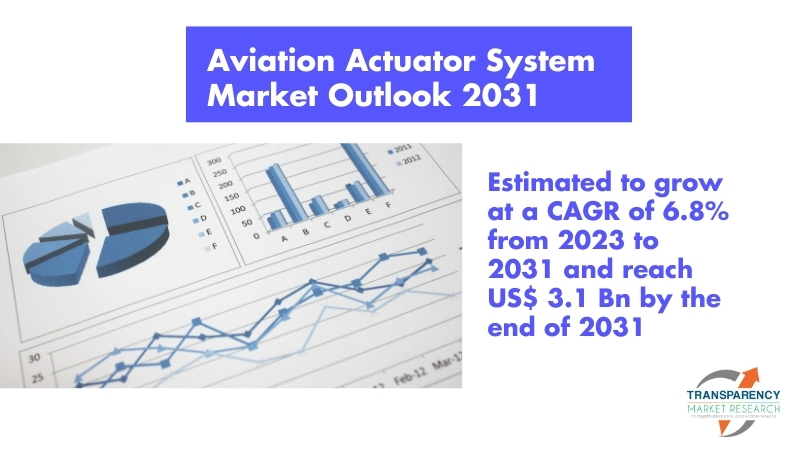
Key Findings of the Market Report
- Based on the actuator type, electric actuators are expected to be in high demand in aviation actuator systems.
- In terms of application, the flight control segment is predicted to drive demand for aviation actuator systems.
- The demand for aviation actuator systems is primarily driven by commercial aviation.
- Asia Pacific accounted for a significant share of the global market in 2022.
Global Aviation Actuator System Market: Growth Drivers
- Global air travel demand has become a major driving force in the aviation industry. To meet this demand, airlines are increasing their fleets to meet an increasing demand for advanced and efficient actuator systems.
- As aircraft technology advances, such as introducing more electric aircraft (MEAs) and fly-by-wire systems, sophisticated actuator systems are in increasing demand. In addition to improving performance and efficiency, these systems are lighter and more efficient.
- The aviation industry is subject to strict safety regulations. Various aircraft components, including control surfaces and landing gear, rely heavily on actuator systems to ensure their safe and reliable operation. Safety regulations and standards may contribute to the demand for high-performance actuators.
- Aviation manufacturers are developing more fuel-efficient and environmentally friendly aircraft as sustainability and fuel efficiency become more important. Advanced actuator systems can optimize aircraft performance and reduce fuel consumption.
- Modern military aircraft incorporate advanced technologies for better agility, stealth, and performance, which also drives demand for advanced actuator systems. Next-generation military aircraft and increased defense budgets can boost the aviation actuator market.
- Aerospace researchers and engineers continue to develop advanced materials, sensors, and actuation mechanisms through ongoing research and development efforts. These innovations will likely make actuator systems more efficient and newer.
Global Aviation Actuator System Market: Regional Landscape
- Aviation actuator systems are expected to be a significant market in Asia Pacific. A significant increase in air travel demand has been observed in Asia, along with economic growth and rising incomes. As passenger traffic increases, new aircraft are needed, creating a demand for aviation actuator systems.
- Several Asia Pacific countries have seen a rise in air travel due to their burgeoning middle-class population. People with higher incomes are able to fly more often, resulting in an expansion of airline fleets in the region, driving the demand for advanced aviation technologies, such as actuators.
- Commercial and military fleets in several Asia Pacific countries are being modernized. Modernization often involves improving aircraft performance, safety, and reliability by adopting new and more efficient actuator systems.
- As defense budgets in the Asia Pacific region have increased, new military aircraft have been purchased. Advanced actuator systems are often integrated into modern military aircraft to ensure maneuverability and precise control.
Unlock Growth Potential in Your Industry! Download PDF Brochure: https://www.transparencymarketresearch.com/sample/sample.php?flag=S&rep_id=51987
Global Aviation Actuator System Market: Competitive Landscape
Technology advancements and advanced materials incorporated into aviation actuator system design have created substantial growth opportunities for companies in this field. Leading players are launching new devices to enhance their product portfolios, and a business expansion is being invested to increase profitability and productivity.
Key Players Profiled
- Aero Space Controls Corporation
- General Electric
- Honeywell International Inc.
- ITT INC.
- Microsemi
- Moog Inc.
- PARKER HANNIFIN CORP
- Collins Aerospace
- Safran
- SAM GmbH
- Crissair, Inc.
- Woodward Inc.
Key Developments
- In October 2022, Moog Inc., which manufactures, integrates, and designs discrete and integrated control systems, launched and retrieved an X-61A Gremlins Air Vehicle (GAV) on its fourth flight test. With three GAVs, Gremlins conducted four individual flight sorties, including an airborne recovery mission that lasted 1.4 hours.
- In July 2023, Safran acquired Collins Aerospace’s actuation and flight control business. By acquiring ATA27, Safran gained global leadership in flight control (ATA27) and actuation.
Global Aviation Actuator System Market: Segmentation
By Actuator Type
- Mechanical Actuator
- Hydraulic Actuator
- Electric Actuator
- Others (Including Piezoelectric Actuator, Pneumatic Actuator, and Electrohydrostatic Actuator)
By Application
- Flight Control
- Auxiliary Control
- Utility Actuation
- Others (Including Weapons Bay Door Drive)
By End Use
- Commercial Aviation
- Defense
By Region
- North America
- Europe
- Asia Pacific
- South America
- Middle East & Africa
Buy this Premium Research Report: https://www.transparencymarketresearch.com/checkout.php?rep_id=51987<ype=S
More Trending Reports by Transparency Market Research –
AI in Aviation Market (航空市場における AI)- The industry was valued at US$ 713.3 Mn in 2022 and it is projected to grow at a CAGR of 37.0% from 2023 to 2031 and reach more than US$ 12.1 Bn by the end of 2031
Sustainable Aviation Fuel Market (Markt für nachhaltigen Flugtreibstoff)- The global industry was valued at US$ 186.6 Mn in 2022 and it is projected to grow at a CAGR of 26.2% from 2023 to 2031 and reach more than US$ 402.0 Bn by the end of 2031
About Transparency Market Research
Transparency Market Research, a global market research company registered at Wilmington, Delaware, United States, provides custom research and consulting services. Our exclusive blend of quantitative forecasting and trends analysis provides forward-looking insights for thousands of decision makers. Our experienced team of Analysts, Researchers, and Consultants use proprietary data sources and various tools & techniques to gather and analyses information.
Our data repository is continuously updated and revised by a team of research experts, so that it always reflects the latest trends and information. With a broad research and analysis capability, Transparency Market Research employs rigorous primary and secondary research techniques in developing distinctive data sets and research material for business reports.
Contact:
Transparency Market Research Inc.
CORPORATE HEADQUARTER DOWNTOWN,
1000 N. West Street,
Suite 1200, Wilmington, Delaware 19801 USA
Tel: +1-518-618-1030
USA – Canada Toll Free: 866-552-3453
Website: https://www.transparencymarketresearch.com
Email: sales@transparencymarketresearch.com
Follow Us: LinkedIn| Twitter| Blog | YouTube

© 2024 Benzinga.com. Benzinga does not provide investment advice. All rights reserved.
ServiceNow Sales Growth Fails to Impress AI-Hungry Investors
(Bloomberg) — ServiceNow Inc. reported strong third-quarter sales and bookings as the software company expands its suite of AI tools.
Most Read from Bloomberg
Subscription sales, which account for the bulk of ServiceNow’s revenue, increased 23% to $2.7 billion in the period, the company said Wednesday in a statement. Current remaining performance obligation, a measure of booked sales, increased 26% in the period ending Sept. 30. Both exceeded analysts’ estimates.
The Santa Clara, California-based company makes applications that help companies organize and automate their personnel and information technology operations. Like its peers, ServiceNow is baking generative AI features into its products and offers a pricier tier with those tools.
The company’s main generative AI assistant product, Now Assist, is the fastest-growing in company history, Chief Executive Officer Bill McDermott said in an interview. The average contract premium for users of Now Assist is 30%, he added.
The shares hit a record high Thursday in New York, jumping about 6%. Investors were initially unimpressed with the results, with the stock trading down Wednesday evening. The shares had increased 28% this year through Wednesday’s close. That’s more than twice the rally seen in the iShares Expanded Software ETF, which is often used as a sector benchmark.
The results “validate the company’s rare standing in enterprise software,” wrote Tyler Radke, an analyst at Citigroup. He cited strong execution in a tough environment for tech spending and early monetization of generative AI.
In recent weeks, ServiceNow and software peers like Salesforce Inc. and Microsoft Corp. have begun emphasizing AI “agents” that can complete tasks without user supervision. Some customers are already trying ServiceNow’s agents, which will be released more broadly next month, McDermott said. Once the agents are fully rolled out, they’ll be priced differently from other products, McDermott added.
For the current quarter ending in December, ServiceNow projected subscription revenue of about $2.88 billion, just ahead of analyst estimates. The company expects near-term bookings to rise 21.5%.
This bookings guidance was effectively “good, but not great,” Kirk Materne, an analyst at Evercore ISI, said in a note. He added that the company tends to issue conservative forecasts for the fourth quarter.
The Plaza at Hazeltine Multifamily Community in Chaska, Minn. to Celebrate Grand Opening on October 30
Four-story, 112-unit community-centered property offers unique breezeway and the best of modern amenities
CHASKA, Minn., Oct. 24, 2024 /PRNewswire/ — Trident Development, a Minnesota-based firm specializing in the acquisition and development of luxury rental apartments, is set to celebrate the opening of The Plaza at Hazeltine, a multifamily community located at 1130 Hazeltine Boulevard, with its project partners, city representatives and residents. The event will begin at 4 p.m. CT on Wednesday, October 30.
“From the beginning, our goal in developing The Plaza at Hazeltine has been to create a destination that is seamlessly connected to the surrounding community,” said Carin Bzdok, vice president at Trident Development. “By working shoulder-to-shoulder with our partners and the city of Chaska, we have achieved that goal and then some. With multiple living options and a wide range of modern amenities, residents are immersed in this wonderful city, taking pride in truly calling this home.”
Located at the southwest corner of Hazeltine Boulevard and Hundertmark Road, The Plaza at Hazeltine features studio/alcove, one, two and three-bedroom apartment options with luxury finishes, modern appliances and golf course views. Residents have access to an underground, climate-controlled parking garage with 100 stalls, and partial ground level covered parking with 30 stalls. The first residents began moving in in early September 2024.
The Plaza at Hazeltine is conveniently situated near a bustling retail area with Kohl’s, McDonald’s, Aldi, Chipotle and Starbucks. The location makes the most of its pedestrian walkways to the retail shops and recreational facilities, including The Loop at Chaska public golf course and the world-renowned Hazeltine National Golf Club.
Amenities include a large outdoor patio with pergola, grilling stations and firepit with comfortable seating, walking trails, a children’s play area, outdoor putting green, dog park, pet wash, bike racks, spacious community room, coffee bar, package delivery room, expansive fitness room, golf simulator, plaza breezeway through the building and a fourth-floor sky deck featuring a rooftop patio.
The general contractor for The Plaza at Hazeltine is Lyon Contracting and the property is managed by Village Green.
For more information on The Plaza at Hazeltine, visit plazaathazeltine.com.
About Trident Development, LLC
With offices and properties in Minnesota and Montana, Trident Development specializes in creating high-quality, safe, and well-appointed senior living and luxury apartment communities. Through comprehensive market research, each project is tailored to meet the specific needs of its community. With a team of seasoned real estate professionals, Trident oversees every stage from site selection to construction financing, ensuring excellence from inception to completion and beyond. For more information, visit tridentdevelopmentmn.com.
![]() View original content to download multimedia:https://www.prnewswire.com/news-releases/the-plaza-at-hazeltine-multifamily-community-in-chaska-minn-to-celebrate-grand-opening-on-october-30-302286027.html
View original content to download multimedia:https://www.prnewswire.com/news-releases/the-plaza-at-hazeltine-multifamily-community-in-chaska-minn-to-celebrate-grand-opening-on-october-30-302286027.html
SOURCE Trident Development, LLC
Market News and Data brought to you by Benzinga APIs
© 2024 Benzinga.com. Benzinga does not provide investment advice. All rights reserved.
Tesla stock soars 13% thanks to an earnings beat and Elon Musk's 'best guesses'
Tesla (TSLA) stock is staying strong in trading Thursday after the company delivered earnings that largely surprised Wall Street and Elon Musk delivered a new round of optimistic forecasts.
The automaker reported improved operating profit margins, automotive gross profit margins excluding the benefits of regulatory credits, and better earnings per share than analysts had expected for the July to September quarter. It also reported better than expected net income and its lowest cost per goods sold ever, at about $35,100 per vehicle.
It’s the first time in seven quarters — that’s almost two years — that Tesla has grown its earnings.
Cannacord Genuity analyst George Gianarikas reiterated a buy rating and raised his price target to $278 per share from $254 per share. A number of analysts across firms like KGI Securities and Goldman Sachs (GS) likewise raised their price targets. J.P. Morgan (JPM) analysts maintained an underweight rating and raised their price target to $135 per share from $130 per share.
“There is more wood to chop for Tesla and this recovery story still has some challenges ahead to convince the Street that 2025 will be a true inflection point year,” Wedbush Securities analyst Dan Ives said in a note Thursday, adding that the Tesla has taken its “first major step” to recovery. Wedbush maintained its $300 per share price target and an outperform rating.
Tesla stock was down roughly 2% when the market closed on Wednesday. As of early Thursday morning, shares have gained more than 13%, returning the stock to about here it was before Tesla’s “underwhelming” robotaxi product demonstration left Wall Street with more questions than answers.
On Wednesday, Musk gave investors a lot to look forward to, assuming that his promises and “best guess” estimates ring true. He reiterated that the company aims to begin scaling production of its Cybercab robotaxis in 2026, with plans to eventual make between 2 million and 4 million units per year; that’s more units than Tesla sells electric vehicles.
“That will be in more than one factory, but I think it’s at least 2 million units a year, maybe 4 million ultimately,” Musk said, adding that he’s talking about his “best guesses.”
Musk also said Tesla expects to begin offering rideshare services next year in at least two states, California and Texas, where he also plans to get regulatory approval for “fully autonomous unsupervised” Full Self-Driving (FSD). Many valuations of Tesla’s current and future stock price account for a planned robotaxi network, which Musk has called a “combination of Airbnb (ABNB) and Uber (UBER).”
Tesla has been operating its own rideshare network for employees at its facilities in California’s Bay Area using current models and a driver at the wheel, executives said Wednesday. Palo Alto, California, is in talks to use Tesla’s newly-unveiled robotaxi in its rideshare program, but the company doesn’t plan to begin making those cars until 2026.
Tesla has, so far, sold more than 1.29 million electric vehicles in 2024, including 462,890 units delivered between July and September. That doesn’t give the company much wiggle room to reach or beat 1.8 million sales — its 2023 record — by the end of the year. But the automaker said it expects “slight growth” in deliveries this year, which would require fourth-quarter sales of more than 516,000 units.
Musk said his “best guess” is for deliveries to reach 20% to 30% growth next year, citing Tesla’s plans to begin selling more affordable models in early 2024.
Billionaire Ken Griffin Sold 79% of Citadel's Stake in Nvidia and Is Piling Into Another Artificial Intelligence (AI) Stock With a Competitive Moat
A little over two months ago, on Aug. 14, investors received what can arguably be described as the most important data release of the third quarter — and I’m not talking about any inflation report.
No later than 45 calendar days following the end to a quarter, institutional investors with at least $100 million in assets under management (AUM) are required to file Form 13F with the Securities and Exchange Commission. This filing tells investors which stocks, exchange-traded funds (ETFs), and occasionally options, Wall Street’s top money managers purchased and sold in the latest quarter (in this case, the June-ended quarter).
As you might imagine, professional and everyday investors are particularly interested in seeing how Wall Street’s smartest asset managers are approaching artificial intelligence (AI) stocks. AI has been the hottest trend over the last two years, with the analysts at PwC expecting this technology to provide a $15.7 trillion boost to the global economy by 2030.
Interestingly, 13Fs from the second quarter show that billionaire investors, including Citadel’s Ken Griffin, have a mixed view of the companies powering the AI revolution.
Since its inception in 1990, Citadel’s hedge fund has been more successful generating investment gains than any other hedge fund. It’s why investors wisely pay attention to what Griffin and his team are buying and selling.
During the June-ended quarter, Griffin oversaw the disposition of a sizable percentage of his fund’s stake in market-leading AI stock Nvidia (NASDAQ: NVDA), but chose pile into another AI company that appears to have a virtually insurmountable moat.
Let me preface this discussion by pointing out that Citadel is an active hedge fund with countless positions, and it often hedges its common stock holdings with put and/or call options. With this being said, perhaps no sell-side activity stood out more during the second quarter than Griffin and his crew shedding 79% of their fund’s stake in Nvidia.
Since 2023 began, Nvidia’s stock has gained 844%, as of the closing bell on Oct. 18, 2024, and tacked on close to $3 trillion in market cap. These are never-before-seen gains from a market-leading business, which suggests that profit-taking played at least some role in Citadel reducing its sizable position. But there’s a reasonable chance this selling activity is about more than benign profit-taking.
To start with, competition is coming at Nvidia from all angles. Rival chipmakers are developing and ramping production of AI-graphics processing units (GPUs) designed to complete with Nvidia’s ultra-popular H100 GPU and next-generation Blackwell GPU architecture. Although Nvidia’s hardware shouldn’t have any trouble maintaining a computing advantage in AI-accelerated data centers, competing chips are cheaper and may be easier for businesses to get their hands on.

